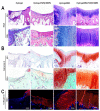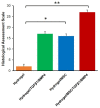Regeneration of Osteochondral Defects by Combined Delivery of Synovium-Derived Mesenchymal Stem Cells, TGF-β1 and BMP-4 in Heparin-Conjugated Fibrin Hydrogel
- PMID: 36559710
- PMCID: PMC9780905
- DOI: 10.3390/polym14245343
Regeneration of Osteochondral Defects by Combined Delivery of Synovium-Derived Mesenchymal Stem Cells, TGF-β1 and BMP-4 in Heparin-Conjugated Fibrin Hydrogel
Abstract
The regeneration of cartilage and osteochondral defects remains one of the most challenging clinical problems in orthopedic surgery. Currently, tissue-engineering techniques based on the delivery of appropriate growth factors and mesenchymal stem cells (MSCs) in hydrogel scaffolds are considered as the most promising therapeutic strategy for osteochondral defects regeneration. In this study, we fabricated a heparin-conjugated fibrin (HCF) hydrogel with synovium-derived mesenchymal stem cells (SDMSCs), transforming growth factor-β1 (TGF-β1) and bone morphogenetic protein-4 (BMP-4) to repair osteochondral defects in a rabbit model. An in vitro study showed that HCF hydrogel exhibited good biocompatibility, a slow degradation rate and sustained release of TGF-β1 and BMP-4 over 4 weeks. Macroscopic and histological evaluations revealed that implantation of HCF hydrogel with SDMSCs, TGF-β1 and BMP-4 significantly enhanced the regeneration of hyaline cartilage and the subchondral bone plate in osteochondral defects within 12 weeks compared to hydrogels with SDMSCs or growth factors alone. Thus, these data suggest that combined delivery of SDMSCs with TGF-β1 and BMP-4 in HCF hydrogel may synergistically enhance the therapeutic efficacy of osteochondral defect repair of the knee joints.
Keywords: BMP-4; TGF-β1; controlled release; heparin-conjugated fibrin hydrogel; osteochondral defect; regeneration; synovium-derived mesenchymal stem cells.
Conflict of interest statement
The authors declare no conflict of interest.
Figures







Similar articles
-
Repair of osteochondral defects with biodegradable hydrogel composites encapsulating marrow mesenchymal stem cells in a rabbit model.Acta Biomater. 2010 Jan;6(1):39-47. doi: 10.1016/j.actbio.2009.07.041. Epub 2009 Aug 4. Acta Biomater. 2010. PMID: 19660580 Free PMC article.
-
Silk fibroin hydrogel scaffolds incorporated with chitosan nanoparticles repair articular cartilage defects by regulating TGF-β1 and BMP-2.Arthritis Res Ther. 2021 Feb 2;23(1):50. doi: 10.1186/s13075-020-02382-x. Arthritis Res Ther. 2021. PMID: 33531052 Free PMC article.
-
Cytomodulin-10 modified GelMA hydrogel with kartogenin for in-situ osteochondral regeneration.Acta Biomater. 2023 Oct 1;169:317-333. doi: 10.1016/j.actbio.2023.08.013. Epub 2023 Aug 15. Acta Biomater. 2023. PMID: 37586447
-
Osteochondral tissue engineering‑based subchondral bone plate repair (Review).Mol Med Rep. 2025 Jun;31(6):152. doi: 10.3892/mmr.2025.13517. Epub 2025 Apr 11. Mol Med Rep. 2025. PMID: 40211705 Free PMC article. Review.
-
Progress in Composite Hydrogels and Scaffolds Enriched with Icariin for Osteochondral Defect Healing.Gels. 2022 Oct 12;8(10):648. doi: 10.3390/gels8100648. Gels. 2022. PMID: 36286148 Free PMC article. Review.
Cited by
-
A review of advanced hydrogels for cartilage tissue engineering.Front Bioeng Biotechnol. 2024 Feb 8;12:1340893. doi: 10.3389/fbioe.2024.1340893. eCollection 2024. Front Bioeng Biotechnol. 2024. PMID: 38390359 Free PMC article. Review.
-
Comparative Efficacy of Endogenous Stem Cells Recruiting Hydrogels and Stem Cell-loaded Hydrogels in Knee Cartilage Regeneration: A Meta- analysis.Curr Stem Cell Res Ther. 2024;19(7):993-1008. doi: 10.2174/1574888X19666230914123443. Curr Stem Cell Res Ther. 2024. PMID: 37711133
-
3D Bioprinting of Hyaline Articular Cartilage: Biopolymers, Hydrogels, and Bioinks.Polymers (Basel). 2023 Jun 15;15(12):2695. doi: 10.3390/polym15122695. Polymers (Basel). 2023. PMID: 37376340 Free PMC article. Review.
-
Advances in growth factor-containing 3D printed scaffolds in orthopedics.Biomed Eng Online. 2025 Feb 7;24(1):14. doi: 10.1186/s12938-025-01346-z. Biomed Eng Online. 2025. PMID: 39920740 Free PMC article. Review.
-
Osteoarthritis: Mechanisms and Therapeutic Advances.MedComm (2020). 2025 Aug 1;6(8):e70290. doi: 10.1002/mco2.70290. eCollection 2025 Aug. MedComm (2020). 2025. PMID: 40757100 Free PMC article. Review.
References
-
- Huang Y.Z., Xie H.Q., Silini A., Parolini O., Zhang Y., Deng L., Huang Y.C. Mesenchymal stem/progenitor cells derived from articular cartilage, synovial membrane and synovial fluid for cartilage regeneration: Current status and future perspectives. Stem Cell Rev. Rep. 2017;13:575–586. doi: 10.1007/s12015-017-9753-1. - DOI - PubMed
Grants and funding
LinkOut - more resources
Full Text Sources

